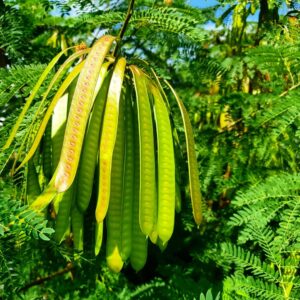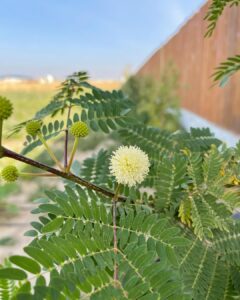Discover easy Tips to Grow River Tamarind in this comprehensive guide to help your plant thrive and stay healthy.
Learn the best tips and learn how to grow River Tamarind successfully with these helpful tips and techniques for optimal care and maintenance. Watch your plant thrive and flourish!
Botanical Name: Leucaena leucocephala
Common Names: White Leadtree, Pearl Wattle, phak krathin, Jumbay, Tan-tan, White Popinac, guaje, miracle tree, Koa Haole, subabul, and Ipil-ipil
Learn Tips to Grow a Papaya Tree
What is River Tamarind?

River Tamarind (Leucaena leucocephala) belongs to the Fabaceae family and is native to Central America and parts of South America.
This small to medium-sized tree exhibits delicate, fern-like foliage with bipinnately compound leaves. It reaches a height of 16 feet and occasionally grows up to 20 to 50 feet. The leaflets of this tree are small. The tree has light gray or brown bark, and its branches spread out to make a beautiful canopy. River Tamarind is famous for producing lots of pretty, fluffy white flower clusters that look like powder puffs.
River Tamarind is famous for its rapid growth rate, nitrogen-fixing ability. This tree has valuable qualities, such as providing fodder for livestock, controlling soil erosion, and serving as green manure. Its durable wood also finds use in firewood, construction, and furniture.
However, when introducing this tree to new regions, one should be cautious of potential invasiveness and consider local climate and soil conditions. With proper management, River Tamarind can offer numerous environmental and agricultural benefits.
Fact: In the 1970s and 1980s, River Tamarind was hailed as a “miracle tree” due to its many uses. However, it has also been called a “conflict tree” as it is used for animal feed but can grow uncontrollably like a weed in certain areas.
Learn How to Grow Toona Sinensis ‘Flamingo’ Tree
How to Propagate River Tamarind

River Tamarind can be grown from seeds, stem cuttings, air layering, or grafting. But the easiest way is to use plant cuttings for propagation.
From Stem Cuttings:
- The best time to take cuttings is during the early morning or late afternoon in the spring or early summer when the plant is actively growing.
- Look for healthy branches that are free from diseases, pests, or damage. The cuttings should be approximately 6 to 8 inches long and have at least two sets of leaves.
- Ensure you have a sharp and clean pair of pruning shears or a knife to take the cuttings. Clean tools reduce the risk of transmitting diseases.
- Make a clean, diagonal cut just below a leaf node (the area where the leaf is attached to the stem) using the pruning shears or knife.
- Trim off the lower set of leaves from the cutting, leaving only one or two sets of leaves at the top.
- River tamarind cuttings can be rooted in a variety of mediums like sand, perlite, vermiculite, or a mix of these with peat or coconut coir.
- Make holes in the planting medium using a pencil or stick and insert the cuttings about 2 to 3 inches deep into the medium. Plant the cuttings at least a few inches apart from each other to provide enough space for root development.
- After planting, water the cuttings thoroughly to settle the soil around them. Ensure the medium remains consistently moist but not waterlogged throughout the rooting process.
- River tamarind cuttings prefer warm and humid conditions. You can cover the cuttings with a clear plastic bag or place them in a propagator to maintain high humidity levels.
- Place the cuttings in a location with bright, indirect light to prevent them from getting too hot or dry.
- Once the cuttings have developed a healthy root system, you can transplant them into individual pots or directly into the garden.
Learn How to Grow Amla Tree
Ideal Pot Size for River Tamarind
The River Tamarind can grow into a medium-sized tree, so it needs a pot that allows its roots to spread out. Choose a pot that is at least 12-16 inches wide and 12-14 inches deep.
Make sure the pot has holes at the bottom to let the excess water drain out. This helps prevent the roots from getting too wet, which can cause them to rot. It’s important to have good drainage for the tree to stay healthy.
Note: As the plant grows, you might need to transfer it to a bigger pot later on. Keep in mind the available space you have indoors or outdoors, depending on where you want to grow the tree.
Learn How to Repair Tree Struck by Lightning
Growing Conditions for River Tamarind

Sunlight
The River Tamarind requires 6-8 hours of direct sunlight daily, thriving in full sun to partial shade conditions. Look for a spot that receives plenty of sunlight and is protected from strong winds. This tree does best in warm climates and can be grown indoors near a sunny window or outdoors in places where it can thrive.
Soil
The River Tamarind plant thrives in soil that drains well and has a slightly acidic to neutral pH, which means it should be around 6.0 to 7.5. It can grow in different soil types like sandy, loamy, or clay. But, the soil should be fertile, have organic matter, and hold some moisture without getting too wet.
Water
The River Tamarind can handle drought once it’s matured, but it needs consistent watering during its early growth. Keep the soil evenly moist but not soggy. Allow the topsoil to dry slightly between waterings to avoid overwatering. Adjust the watering frequency based on the weather and how well the soil retains moisture.
Temperature and Humidity
The River Tamarind tree loves warm temperatures, ideally between 68°F to 86°F (20°C to 30°C). It prefers a moderately humid environment, but it can still handle lower humidity levels.
If possible, try to maintain the humidity around 40-60%, especially when growing it indoors. Remember, the River Tamarind is sensitive to frost and freezing temperatures, so protect it from these conditions as it cannot tolerate them.
Read Ylang-Ylang Tree Growing and Care Guide
River Tamarind Care

Fertilizer
To help River Tamarind grow well and stay healthy, it needs regular fertilization. During the growing season, use a balanced, slow-release fertilizer with an NPK ratio of 10-10-10 or 14-14-14.
Be careful not to use too much fertilizer, which can cause too many leaves and less flowering and fruiting. After applying the fertilizer, make sure to water the tree thoroughly to avoid harming its roots.
Pruning
Trimming or pruning River Tamarind is important to keep its shape, make it bushier, and get rid of dead or sick branches. It’s best to do this when the tree is not growing much.
Use clean and sharp tools to make neat cuts without hurting the branches. Take out any branches that are crossing or too close together, so the air can flow through the tree.
Also, cut the lower branches to make the trunk the right height. Regular pruning helps the tree look neat and more well-arranged.
Pest and Diseases
River Tamarind is usually strong and can handle pests and diseases well. But sometimes, it might face problems with pests like aphids, mealybugs, and scale insects. Check the tree often, and if you see any bugs, act quickly.
To treat affected areas, use a gentle insecticidal soap or neem oil spray following the product instructions. Keep the tree clean, check it regularly, and ensure it grows in a healthy environment to prevent pest and disease issues.
Read Texas Star Hibiscus Growing Information
FAQs

Q.1. Are the Seeds of River Tamarind Edible to eat?
The seeds of River Tamarind can be eaten, but they need special preparation to remove toxins and make them easier to digest. If you plan to eat the seeds, make sure to research and follow the right procedures for safe consumption.
Q.2. How Long Does It Take for River Tamarind to Bear Fruit?
River Tamarind usually begins to produce seed pods after about 2-3 years of growth. However, it takes around 5-7 years for the tree to reach its full fruiting potential.
Q.3. Can River Tamarind Tolerate Drought?
Once River Tamarind is well-established, it can tolerate moderate drought. But during long dry periods, it’s best to give it extra water to keep it healthy and strong. Water the tree deeply but not too often, as this will encourage its roots to grow deep into the soil.
Q.4. How to Grow River Tamarind From Seeds?
To grow River Tamarind from seeds, first, collect ripe seed pods. Open the pods and take out the seeds. Soak the seeds in warm water for a day. Then, plant the seeds about 1 inch deep in soil that drains well. Keep the soil damp and put the seeds in a warm spot with indirect sunlight for them to sprout.



